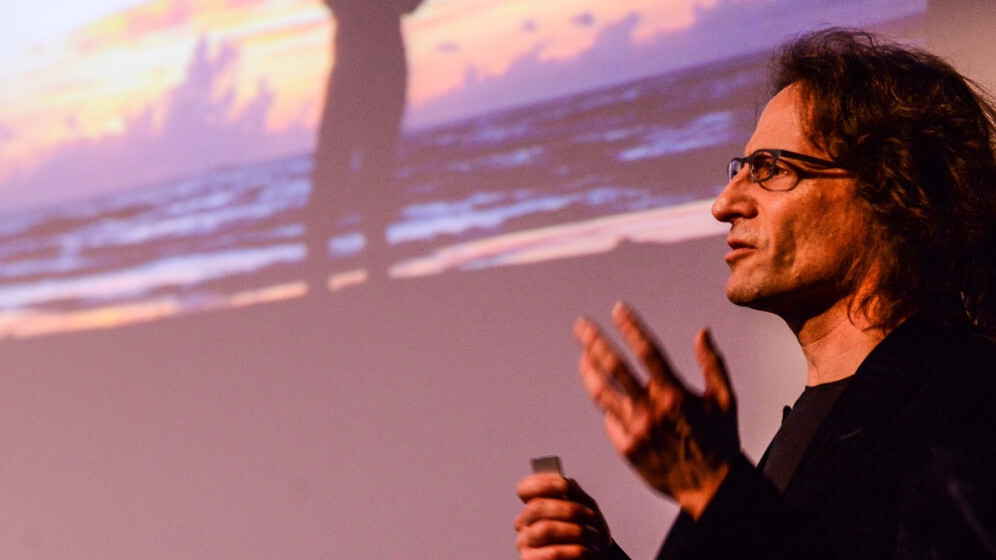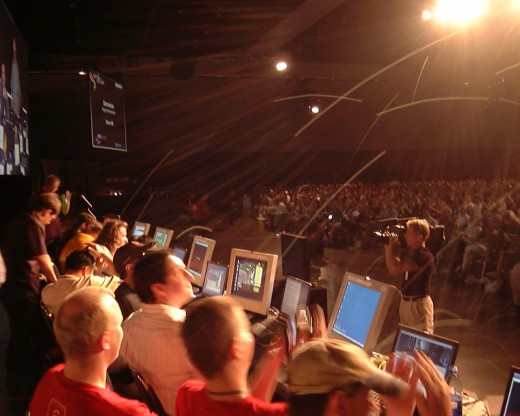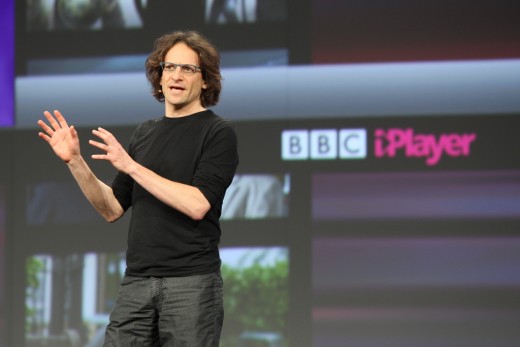
Anthony Rose is Co-founder and President at Beamly, the social and content network for television. His latest venture, UTD removes the friction in how people connect by uncovering the common ground between them.
At some point you’re going to be asked, or given the opportunity, to do a public presentation. It could be in front of your colleagues, it could be at a developer conference, or to a group of VCs.
If you’re lucky you’ll be right in your comfort zone – a topic you’re familiar with, in front of a small friendly audience, where the stakes for the success or failure of your presentation are low.
But for sure the day will come when you’re faced with a high-stakes presentation, possibly outside your comfort zone, in front of a huge audience of peers, investors or industry heavyweights. It’s stressful! There’s no way to avoid that pit in your stomach… ‘Why am I doing thIS?’ ‘Will it all go wrong on the night’ ‘Whose stupid idea was this?’ ‘I could be chilling out right now on the couch at home instead of pacing back and forth trying to memorize my lines….’
Some people just look so natural on stage… how do they do it? If you’re an actor, sure, that’s what you’re trained for. But what about we tech people – the reason we’re into tech is that love to spend our time happily listening to music, typing away and not having to be put on the spot in front of our peers.
So let me tell you about my baptism by fire, and the method I use to stay calm and hopefully deliver a compelling pitch and performance. Here goes…
Baptism by pingpong balls
Way back in the late 1990s I was CTO at Brilliant Digital Entertainment, developing a real-time 3D engine for streaming animated interactive content over the web.
One day we got a call: ‘Great news guys, you’ve been selected as one of the top 3D companies in the world, you get to demo your 3D engine at Web3D Roundup as part of Siggraph 2000 in New Orleans.’
Now for those who don’t know Siggraph, it’s the biggest annual computer graphics conference. It’s huge. To be invited to present at Web3D Roundup was a great honor. We were made! Exciting times!
I figured that as the company CTO the buck stopped with me to do the on-stage presentation. I knew the technology best, I figured I did a halfway decent presentation, and, well, a lot of tech needed to work on the night, this being an actual live presentation. I should do it.
Intel sent us special pre-release hardware with the latest speedups and 3D hardware, as we were on its developer program. Our team worked into the night for weeks doing every bit of optimization we could to increase the frame rate, improve the lip-sync, improve the shader, get better texturing.
“Ed, are you sure this is the best time to rewrite that part of our 3D engine this close to the event?” You can see what’s coming next…
Cut to the day before the big Web3D Roundup event. I’m in steamy New Orleans, juggling manning our booth on the crazy noisy exhibition floor with calls to our team in Australia to get updated code drops.
The demo was taking shape, but it became apparent we had a bit of a reliability problem – the Web3D Roundup presentation had to be 3 minutes – exactly three minutes, more on that below – but in my rehearsal runs our 3D engine never lasted much more than a minute before it crashed. And a crash in front of the Siggraph audience, that would not be good.
Many hours later, and a bunch more code drops hastily cobbled together and, ooh, it ran all the way through. This might just work…
It’s now the day of Web3D Roundup. I walk into the auditorium. It’s HUGE. And then the organisers read the rules:
“There will be 3000 people in the audience. Every person will have a whoopee cushion and a ping-pong gun. If you go over your allocated time by even one second, the audience have orders to shoot you with ping-pong balls. If your demo pauses or crashes, or if you’re boring, the audience have orders to use the whoopee cushions”.
“Now, everyone (of the 20 companies presenting), you have 1 minute, except for Brilliant Digital (that’s me!) and two others – you’re going first, you have 3 minutes each”.
We’re one of the three top finalists, we get a whole three minutes. But… our hot-rodded 3D engine running on this pre-release Intel hardware has a tendency to explode after one minute. This could go really really badly.
“One last thing: There’s a free bar before the event (ironically our company was sponsoring that free bar) so the audience will be slightly inebriated. Good luck, gentlemen.”
So let me see…
- I put myself forward within the company to do this presentation, in fact I insisted on it pretty much everyone in the 3D world would be in the audience.
- Intel’s management team and engineers, the ones who invited us to their prestigious developer program, would be in the audience our 3D engine crashed in 8 out of 10 rehearsals… could I really trust that last patch release delivered at 3am Australian time?
- The company was coming up for another investment round, if we crashed and burned that could be the end of the company
- As CTO the buck stopped with me, there was nowhere to hide
- Oh, and there were 3,000 drunk people in the audience armed with ping-pong guns and whoopee cushions waiting for an opportunity to use them.
So no stress then!
The event begins. The first company on, their 3D player has problems. A minor glitch. The whoopee cushions erupt. Next company up, another problem. Shot with ping-pong balls.
My turn.
Miraculously, the demo worked perfectly. The 3D player ran without a glitch (why couldn’t it always work that way?!). My demo and pitch finished precisely on three minutes. Like, with not a second to spare. Applause.

On stage at Web3D Roundup, 2000 (I’m the long-haired guy 3rd from the far end). And, yes, that’s a hail of incoming ping-pong balls.
Man, that was tough. I’ll never, ever, do that again. Or so I said to myself at the time. But it’s such an adrenaline kick that when the next invitation comes something inside you says “do it, do it, I dare you”. And you meekly say “sure, I’d love to!”.
So now when I’m faced with an important presentation, before I step on stage I say to myself “are there 3,000 inebriated people out there waiting to shoot you? Does the success of the company depend on this presentation? Is your demo dependant on a buggy 3D engine whose last build shipped at 3AM by a developer who hadn’t slept for two days?”.
No? Excellent. Chill dude, relax.
Learning from experience
Well, at least you can relax until you look out to see even more people in the audience – that was a decade later at Microsoft PDC, where I had 5 minutes on stage, timed to the second, to present unreleased in-development BBC iPlayer code that synched your social and movie experiences through Azure onto 3 devices, live on stage. 3000+ people in the audience, many times that watching live online.
I took a deep breath, thought about my baptism of fire a decade earlier, and strode out onto the stage. HUGE audience. But they look pretty sober. And not armed. Chill.
The presentation gods must have been smiling. The presentation went great, the tech worked without a hitch.
I since learned that after Bill Gates’ famous blue screen of death experience, major Microsoft presentations have multiple backups – two or three of everything – with instant cutover to a shadow team who are running the exact same presentation on independent hardware.

On stage at Microsoft PDC, 2010
So my advice is, if you’re not comfortable striding out onto a stage and putting yourself out there, just think of a truly worst-case scenario in terms of audience and importance. Now chill, this one’s way smaller.
Ommmmmmm.
But, never take your audience for granted. Even if it’s a small low-key presentation, take your talk and your audience as seriously and don’t skimp on the prep. If you’re not nervous before the presentation, you’re not taking it seriously enough. So, a few butterflies are just fine.
Here’s my pre-talk checklist:
1. One week before
Think about the audience. Are they executives? VCs? Tech / developers? Journalists? People who are expert in your field, or people who know little about it. This is critical, you need to understand the audience if you’re to have a message that that understand and which draws them to a conclusion.
Last week I presented at a government policy forum – you just needed to look out into the audience to see how non-techie they were – people had notepads and pens and were taking actual written notes. And yet the panellists kept using deep industry buzzwords and acronyms, it was clear the audience didn’t have a clue what they were going on about. So, if you’re in doubt, call the organisers and ask them about the audience demographic.
2. Six days before
Start thinking about the key message you want to get across – if there’s just one point you want to make, what is it? Once you have that, weave your entire presentation around that to create a story, a journey that you take the audience on. Sometimes this is the hardest part – if you can’t figure out a story and a destination, then your talk doesn’t have a purpose.
No need to write anything down yet, just mull over it while you’re in the bath, out jogging, in the tube.
3. Four days before
Start creating the point-by-point story arc for your presentation. I usual start with four or five main themes or segments – if each of those get 3-4 sub-points then you have about the right amount of content for a 20 minute presentation.
Importantly, your message is 4 main things, each with some level of detail, rather than 20 little things, which is message overload.
4. Three days before
Spend a few hours getting images for each point you want to make. I’m big on PowerPoints that have lots of images and little or no text.
The images serve three purposes: 1) eye candy for the audience, 2) as a prompt to you for the next point in your presentation to talk about because you won’t be using notes on the day (see below), and 3) if you do get lost in your train of thought on the day, those slides will act as an aide memoire.
5. Two days before
You now have a 20 or so slides, most images, but bullet-point text where needed. Ideally the images and text complements your message, rather than literally restates it.
But how are you going to remember on stage all those great points you wanted to make? Write them down. I find there’s nothing better than sitting with a piece of paper and actually writing down the points you want to make for each slide in your deck – the very act of writing it down, the slow pace of the writing, somehow imprints the message in your brain more effectively than just looking at the pictures and trying to imagine what you’re going to say.
6. A day before
Take a look at your notes, close your eyes, try to say each of the points without having to look at the notes.
7. On the day
Ditto, refresh your memory by looking at those bullet-point notes again.
Then put the notes away – they’re a nice safety net and you can play it safe, but for a great presentation you want to be brave and wing it, no safety net. Like walking a high wire, if you pull it off it will be spectacular but, well, there’s also a long way to fall. That’s the adrenaline kick!
And finally, before you step out on stage, keep thinking about the single story theme, and the four main sub-themes you want to get across. If you get lost out there, knowing those four sub-themes, or even just the main theme, will help you get back on track or even just improvise.
Get the TNW newsletter
Get the most important tech news in your inbox each week.




